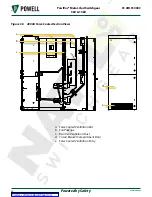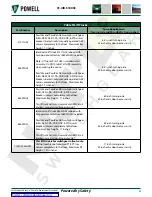
Powered by Safety
®
46
Operation
01.4IB.51000C
PowlVac® Metal-Clad Switchgear
5kV & 15kV
J. t
ruck
-o
perAteD
c
ell
S
WItch
(toc) (o
ptIonAl
)
The purpose of the truck-operated cell switch
(TOC) (Figure 4, g) is to indicate whether or not
the removable element is in the connected
position. When required, the switch is
mounted in the upper right corner in the
secondary compartment. A TOC actuator
(Figure 6, a) mounted on the upper right
corner of the removable element, just behind
the front cover, engages the operating arm
of the TOC switch and operates the switch as
the removable element moves from the test
position to the connected position. When the
removable element is withdrawn, the spring
return mechanism of the switch returns to its
original position.
Figure 35 Typical Compartment Door with
Closed Door or Through-Door
Provisions
k. m
echAnISm
-o
perAteD
c
ell
S
WItch
(moc)
(o
ptIonAl
)
The mechanism-operated cell switch (MOC) is
an auxiliary switch operated by linkages in the
compartment, which operates in conjunction
with the circuit breaker mechanism.
The MOC switch operating arm, which projects
from the jackshaft of the circuit breaker at the
lower left side of the circuit breaker, operates
in conjunction with the MOC assembly. This
arm rides over an angle pivoted on the lower
left side sheet of the compartment. When
the circuit breaker is closed, the arm moves
downward, deflecting the angle.
A linkage to the switch connects the angle,
and the assembly is spring-loaded to the open
position. In the one-high basic construction
and in the lower compartments of the two-
high basic construction, the switch is mounted
in the compartment near the upper left
corner, and the operating linkage extends
downward to the pivoted angle. In the upper
compartments of the two-high construction,
the switch is mounted below the left side of
the circuit breaker, and the operating linkage
extends upward to the pivoted angle. See
Figure 36 and Figure 37. As supplied, the
mechanism-operated cell switch (MOC)
will operate with the removable element in
either the connected or the test position. If
it is desired that the switch operate in the
connected position only, remove the small
bolted-on angle that forms the bottom flange
at the front of the pivoted angle.















































